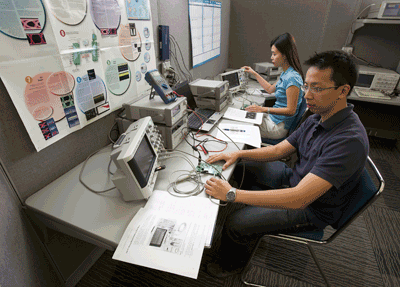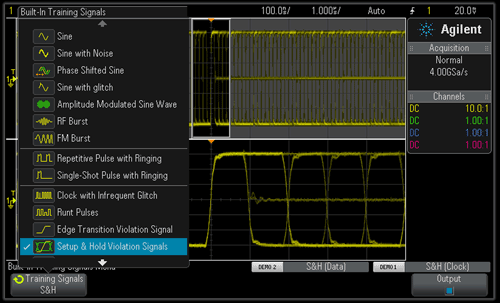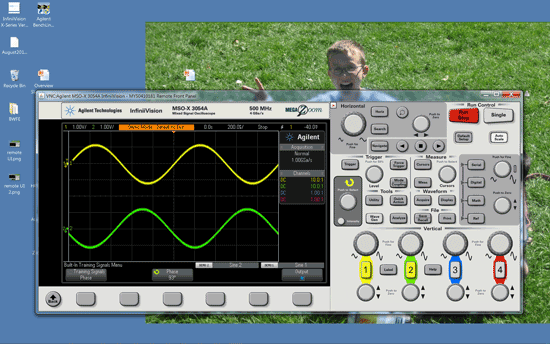Useful tips from the most demanding users
BY PHIL STEARNS
Agilent Technologies
www.agilent.com
No matter how long you have been out of school, you can still learn a great deal from professors —even when it comes to using fundamental tools like oscilloscopes.

It may come as a surprise, but educators — not leading-edge designers — are the most demanding scope users. They have to teach in a wide variety of applications, from power and controls, to signal processing and embedded systems, to FPGA and ASIC design, to RF and microwave communications. Their budgets are always constrained. They have a new batch of novices to train every few months. And they have research assistants who have the time and curiosity to explore the limits of every feature.
In a recent series of interviews, I talked with professors and lab managers about their oscilloscope use and requirements. Common themes emerged that should interest both education and industry users — training new users, safeguarding equipment, remote access and use, and budget management. It’s not surprising — a significant percentage of the visitors to Agilent’s Educators Corner (agilent.com/find/educatorscorner) are not coming from .edu domains.
The basics
I was first introduced to oscilloscopes 20 years ago as a sophomore in the University of Cincinnati Measurements Laboratory. At the time, the introductory material for our Tektronix analog scope was a detailed step-by-step workbook. It was very good at explaining what to do, but not necessarily why we were doing it.
Today, professors take a more organic approach. Most dedicate no more than one lab session to instrument theory. The rest of the introductory process is done in the context of experiments. In the case of UC, the measurement lab still exists, but it is more tightly coupled with the networks course. Some professors have their younger electronics students work with robots, games, microprocessor evaluation kits, and other realistic designs.
The best part of this work is that professors are generally happy to share their creations. If you are designing a lab or bringing novice employees up to speed, you can find a wealth of measurement theory and lab content at sites like Educators’ Corner, supporting organizations like ASEE, or by contacting your former ECE department.
Another great source of operation and theory content are the instrument manufacturers. The ones who have significant sales to educators have created labs and seminars that teach measurement theory. Others have user’s guides that teach a basic understanding of features.
Novice-proofing your instruments
Even advanced engineers start at the bottom of the experience curve; and all of us have made something melt or explode as we gained knowledge. When a cheap electrolytic capacitor starts to sizzle, it can be amusing. When you “smoke” a $5,000 instrument, it’s not as funny. Here are a few tips for helping new scope users:
• If you have high-voltage signals, disable the low-impedance amplifier path. Many oscilloscopes have two amplifier paths — a 1-Ω and a more sensitive 50-Ω impedance path. While there are safeguards to protect these circuits, a rapidly changing high-voltage signal can damage the 50-Ω path. Some scopes have programming commands that let you disable this option.
• If possible, disable the Autoscale /Autoset feature. For experienced users, this feature is a time saver. For novices, it can become a crutch that inhibits true learning. The sooner that students have to use “old-school” techniques for operating an oscilloscope, the faster they can master the science of the measurement.
• Don’t use a more expensive probe than you have to. Scope novices excel at breaking the tips, losing accessories, and creating shorts in the cables. If your lab measurements can be made with lower-cost options like low-bandwidth probes, “banana” leads, or direct BNC connections — use them.
• Secure the scope to the bench. While this is always a good practice in an open lab environment, a properly-secured instrument will stay on the bench instead of crashing to the floor. Many professors have stories of future QA engineers testing the limits of a scope’s durability. Most oscilloscopes will have a place to connect an after-market lock and cable system, or have “loop” molded in the plastic for threading a cable. Some offer both.
A connected ecosystem
Educators also use instruments’ connectivity features more than their colleagues in industry. There are several reasons why:
There is a growing interest in teaching students how to network and integrate equipment. Time spent testing a design is not spent perfecting new features or getting a product to market. Professors are teaching students techniques to automate single instruments and complementary combinations to meet this need for efficiency. Tools designed to teach these concepts at universities will also help in teaching programming novices.
In addition, education labs have constraints might match those in your company. Users outnumber equipment, and many students are located remotely from the lab. Features, like remote interfaces, which were designed with educators in mind, are perfect for collaborative learning, remote learning, and after-hours work.

Teaching (working) on a budget
A primary mission of the educator is to teach students how to succeed in a modern engineering environment. A common constraint in the education community is that budgets are tight. Outfitting a lab with new instruments can cost several hundred thousand dollars. As a result, professors and lab managers are particularly shrewd money managers.
Understanding when to upgrade to latest-generation technology can be a challenge. Grants and budgets rarely arrive when they are most needed. So what drives these technology upgrades?
Most often, it’s a simple case of obsolescence. Even reliable instruments can become expensive to maintain and support. In addition, there has been an explosion in performance and features over the last 10 years that make an upgrade necessary.

• Core specifications such as sample rate (which allow real-time operation at higher effective bandwidths), memory depth (which allows more time to be seen at a higher resolution), and update rate (allowing a more “analog-like” view of signals) have increased by at least an order of magnitude.
• Instrument I/O and connectivity have evolved from HPIB and floppy drives to Ethernet, USB, and Compact Flash. These newer technologies simplify documentation, remote access, and interoperability and decrease overall system cost (these busses are native to PCs).
• Important new features have emerged that push the state-of-the-art. These include mixed-signal oscilloscopes (adding digital analysis), triggering and decoding for low-speed serial busses, FPGA analysis, and frequency-domain analysis.
• Overall improvements to the user experience from improvements in interfaces and display technology.
When it’s time to migrate to newer technology, educators have many options. Even economy oscilloscopes will offer performance beyond what is currently on your bench. However, if your objective is to match the capabilities of your counterparts in industry, those scopes are still within your reach. Many of the more advanced features of these instruments are available as post-sale upgrades ; which allows improvements to the lab to be made incrementally.
It’s never too late to head back to school
The hallmark of master engineers is openness to lifelong learning. Whether you are a 40-year veteran or a freshly minted engineer, you can benefit from the tools that were designed to meet the needs of educators and the curriculum that they create for educating the next generation. While the jeans you wore back them probably don’t fit, your capacity for learning still will. ■
About the author
Phil Stearns, Value Oscilloscopes Product Manager, Digital Validation Division, Electronic Measurements Group, Agilent Technologies. Phil holds a BS in Electrical Engineering from the University of Cincinnati, and an MBA from Case Western Reserve University. Phil joined Hewlett Packard/ Agilent in 1996 and has held various positions marketing oscilloscopes and logic analyzers. Phil has also worked outside of Agilent in R&D, marketing, and consulting roles.
Phil is currently the product manager for Agilent’s InfiniiVision oscilloscope product lines and is based in Colorado Springs, Colorado. Outside of work, Phil tries to reverse the entropy caused by three sons and one dog.
Advertisement
Learn more about Electronic Products Magazine





